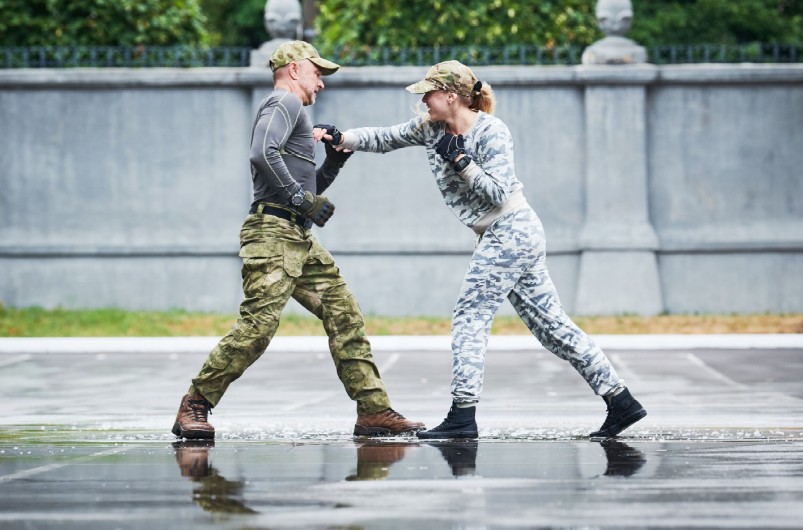Hand-to-hand combat demands a unique combination of strength, endurance, agility, and explosive power. Whether you are training in boxing, Brazilian Jiu-Jitsu, Muay Thai, Krav Maga, or another martial art, developing functional strength is crucial for improving performance and preventing injuries. Unlike bodybuilding or general fitness training, martial arts conditioning focuses on movements that translate directly to combat effectiveness. Brent Suen explores key strength-building exercises that enhance striking power, grappling control, and overall combat readiness.
1. Compound Lifts for Full-Body Strength
Strength is the foundation of combat sports, and compound lifts help develop it efficiently. These exercises engage multiple muscle groups simultaneously, improving overall power and coordination.
Deadlifts
- Strengthens the posterior chain (hamstrings, glutes, lower back) for powerful hip movements.
- Enhances grip strength, crucial for clinching, grappling, and controlling an opponent.
- Builds core stability, improving balance and resilience against takedowns.
Squats (Back and Front Squats)
- Develops explosive leg power for kicks, takedowns, and quick footwork.
- Increases core stability, enhancing resistance to strikes and sudden movements.
- Improves mobility in the hips, knees, and ankles, crucial for agility in combat.
Overhead Press
- Strengthens the shoulders and triceps, essential for punching power and blocking.
- Enhances upper body endurance, allowing fighters to maintain guard positioning.
- Builds core stability to resist rotational forces during striking or grappling exchanges.
2. Bodyweight Training for Functional Strength
Martial artists rely on bodyweight training to develop strength that directly translates to fight performance. These exercises build endurance, flexibility, and coordination.
Pull-Ups & Chin-Ups
- Strengthens the lats, biceps, and forearms for stronger grips and clinching control.
- Improves upper body endurance, crucial for repeated striking and grappling engagements.
- Enhances overall pulling strength, beneficial for takedowns and defensive maneuvers.
Push-Ups & Dips
- Develops chest, triceps, and shoulder strength for more explosive punches.
- Improves muscular endurance, preventing fatigue in later rounds of a fight.
- Enhances core stability, helping fighters maintain proper form under duress.
Pistol Squats
- Improves unilateral leg strength, essential for balance and stability in fighting stances.
- Increases mobility and flexibility, reducing injury risk.
- Strengthens stabilizing muscles, critical for absorbing impact from strikes.
3. Core Training for Stability and Explosiveness
A strong core is essential for generating power in strikes, maintaining balance during grappling exchanges, and resisting body shots.
Russian Twists & Medicine Ball Throws
- Develops rotational strength, crucial for powerful punches and kicks.
- Enhances oblique endurance, helping fighters absorb body shots more effectively.
- Improves overall coordination between upper and lower body movements.
Planks & Hanging Leg Raises
- Builds static and dynamic core strength, reinforcing posture and control.
- Enhances endurance for prolonged clinching and ground-fighting scenarios.
- Strengthens hip flexors, aiding in high kicks and knee strikes.
Ab Rollouts & Windshield Wipers
- Develops anti-rotational strength, increasing resistance to opponent manipulation.
- Enhances the ability to absorb and deliver force efficiently.
- Strengthens deep core muscles, crucial for maintaining posture and mobility.
4. Explosive Power Training for Speed and Impact
Martial artists must be able to generate force quickly. Explosive power exercises develop the fast-twitch muscle fibers responsible for rapid and forceful movements.
Kettlebell Swings
- Improves hip explosiveness for striking and takedown initiation.
- Develops grip endurance, essential for clinch fighting and submission holds.
- Strengthens posterior chain muscles, enhancing overall athletic performance.
Box Jumps & Plyometric Push-Ups
- Builds lower body explosiveness for quick footwork and powerful strikes.
- Enhances reactive power, allowing fighters to respond swiftly to opponent movements.
- Improves neuromuscular coordination, increasing overall speed and efficiency.
Battle Ropes & Sled Pushes
- Increases upper body endurance and striking power.
- Develops cardiovascular conditioning while building muscular stamina.
- Enhances grip and shoulder endurance, crucial for maintaining guard position.
5. Grip and Forearm Strength for Clinching and Grappling
A strong grip gives martial artists better control in clinches, submissions, and weapon disarms.
Farmer’s Carries
- Develops crushing grip strength, critical for controlling opponents in grappling.
- Builds shoulder and core endurance, reducing the risk of fatigue in later rounds.
- Enhances postural stability, improving defensive positioning.
Wrist Curls & Reverse Wrist Curls
- Strengthens wrist stability for better control in striking and grappling.
- Reduces injury risk, particularly for the wrists and forearms.
- Improves punching endurance and resistance to joint locks.
6. Conditioning for Stamina and Recovery
Endurance is just as important as strength in martial arts. A well-conditioned fighter can maintain power output throughout a match and recover quickly between bursts of activity.
Sprints & Interval Training
- Enhances anaerobic conditioning, simulating fight intensity.
- Improves recovery speed between rounds or exchanges.
- Builds explosive energy reserves for powerful strikes and takedown attempts.
Jump Rope
- Develops footwork, agility, and cardiovascular endurance.
- Improves coordination, benefiting both striking and defensive movement.
- Strengthens calves and ankles, reducing the risk of injuries.
Swimming & Rowing Machine Workouts
- Builds full-body endurance with low-impact stress on joints.
- Enhances lung capacity and oxygen efficiency.
- Strengthens back and shoulder muscles for better grappling performance.
Martial arts strength training should focus on functional movements that enhance combat-specific skills. Fighters need a well-rounded routine incorporating compound lifts, bodyweight exercises, core training, explosive power drills, grip strengthening, and conditioning work. A balanced approach to training ensures that strength translates directly into improved combat performance, helping fighters become faster, stronger, and more resilient in hand-to-hand engagements. By incorporating these key exercises into your regimen, you’ll develop the power, endurance, and control necessary to dominate in combat sports while reducing the risk of injuries.
